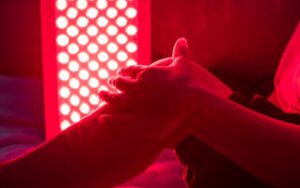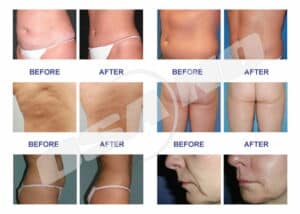Key Takeaways
- Cryolipolysis (also called CoolSculpting) is a non-surgical procedure. It reduces stubborn fat in specific areas of your body – fat that does not respond to diet or exercise alone.
- The device targets and eliminates these fat cells by freezing them without harming the surrounding tissue. If you have stubborn fat in specific areas, this technique might be of interest to you.
- Cryolipolysis treatment involves using cold temperatures to freeze fat cells without affecting the surrounding tissues. You can expect minimal to no downtime after the procedure, which makes it a convenient option for your busy lifestyle.
- Multiple sessions may be necessary to achieve the desired effect, and results are typically seen within a few weeks to months. Patience is key since your body takes time to naturally process and eliminate the fat cells.
- This procedure is not a treatment for obesity and should not replace a healthy lifestyle. Consider it as a complementary solution for areas where fat is not responding to traditional weight loss methods.
- Success rates for cryolipolysis can vary. However, users should have realistic expectations about the outcome.
Understanding Cryolipolysis
Cryolipolysis is a scientific term referred to as ‘fat freezing.’ It is a method of noninvasive body contouring aimed at reducing specific fat cells without surgery. During this procedure, targeted fat areas are exposed to cold temperatures to induce lipolysis, the breakdown of fat cells.
Here’s how it works:
- CoolSculpting treatment is applied to the targeted area.
- This treatment lowers the temperature in a controlled way to freeze fat cells while preserving other tissues.
- The crystallized fat cells eventually die and are naturally eliminated from your body.
CoolSculpting has gained popularity because it involves no needles, incisions, or required downtime.

Preparation and Process
Before undergoing fat freezing, you will consult with a clinician to discuss areas of concern and the desired results. During the procedure, you’ll experience a vacuum suction through specific applicators designed to target the treatment areas such as the abdomen, thighs, love handles, under the chin, and upper arm.
Preparation
- Identification of stubborn areas for treatment
- Skin is marked for precise applicator placement
Process
- Skin is protected with a gel pad
- Applicators then apply controlled cooling through suction
- You might feel intense cold, tingling, or discomfort initially, which usually subsides.
The machine utilizes paddles or suction to hold the cutaneous fat and maintain a consistent cooling effect. You are awake during the treatment, which generally lasts between 35 to 60 minutes, allowing for a return to daily activities soon after.

Post-treatment Recovery and Care
After the treatment, you might experience temporary side effects such as redness, bruising, swelling, tingling, or numbness in the treated areas. You should follow post-treatment instructions carefully to minimize discomfort and ensure the best possible results.
Recovery care
- Gently massage the area
- Apply cold compresses if needed
- Stay hydrated and maintain a healthy diet
Post-treatment expectations
- Gradual fat reduction noticeable over the following weeks
- Full results typically observed within three months
The treated fat cells are processed by your immune system and eliminated through an inflammatory response, leading to a reduction in the thickness of the fat layer. Paradoxical adipose hyperplasia and contour irregularities are potential risks, albeit rare. You do not require downtime for recovery, but results can vary. Therefore, maintaining a balanced diet and regular exercise is essential for lasting changes.
Financial Considerations
The costs can vary widely based on geographic location, the experience of the provider, and the number of treatment areas.
Cost Analysis
The total price depends on several factors:
- The area of your body being treated
- The number of sessions you need
- The geographic location of the clinic
- The experience of the plastic surgeon or specialist
Keep in mind that, typically, multiple treatments are required for optimal results, which can add additional expense.
Insurance Coverage
As a rule, insurance does not cover cryolipolysis since it’s considered a cosmetic treatment. You should consult with your insurance provider, but be prepared for the likelihood that you will need to budget for the entire cost. Some doctor’s offices may offer financing plans to help manage the costs.
Coverage may be possible for medically necessary treatments, including certain procedures performed by plastic surgeons who are members of the American Society of Plastic Surgeons. However, cryolipolysis, like many other cosmetic procedures, usually does not fall into this category.
Pros and Cons of Cryolipolysis
Here’s an overview of potential benefits against possible risks to help you make an informed decision.
Benefits and Advantages
- Non-invasive: It is a non-surgical alternative to liposuction that works by freezing fat cells without harming surrounding tissue.
- No need for anesthesia or incisions. A relatively safe and effective localized body fat removal method.
- Effective fat reduction: Studies show an average fat layer reduction of 20-25% in treated areas.
- It works well on stubborn fat unresponsive to diet/exercise.
- Natural-looking results: Fat loss occurs gradually over weeks/months, so results look natural.
- No major change in body shape, just slimming of targeted spots.
- Minimal side effects: Temporary redness, bruising, numbness, etc.
- No downtime: Treatment sessions take 1-3 hours. Patients can resume normal activities immediately with no recovery needed.
- Customizable: Different body areas can be targeted in the same session. The number of applicators used is tailored to each patient.
- The procedure is suitable for individuals of all ages.
- No damage to nerve fibers, blood vessels, muscles, or lasting damage to the skin in the treatment area.
- Boosts confidence: It helps patients feel more self-assured and comfortable in their bodies.
Risks and Side Effects
- Pain/aching/discomfort: Many patients experience mild to moderate pain, stinging, aching, or discomfort at the treatment site, especially in the first few days after treatment. This usually resolves within 1-2 weeks.
- Temporary skin changes: Short-term side effects like redness, bruising, swelling, numbness, and skin sensitivity at the treatment area are common. These typically go away within a few days/weeks.
- Paradoxical adipose hyperplasia (PAH): An uncommon risk where the fat cells treated actually increase in size rather than decrease. The cause is unknown, but the incidence rate is estimated at around 1 in 138 treatments.
- Other rare risks: In very rare cases, motor neuropathy, severe pain lasting months, abdominal hernias, and skin discoloration have been reported after cryolipolysis treatment.
Patient Criteria and Eligibility
Not everyone is a suitable candidate, and certain areas respond better to the procedure.
For Whom Cryolipolysis Is Not Recommended
Cryolipolysis is designed for people who wish to reduce fat bulges in specific areas but is not recommended if you:
- Suffer from cryoglobulinemia, cold agglutinin disease, or paroxysmal cold hemoglobinuria, as these conditions can be negatively affected by cold treatment.
- Are looking for an obesity treatment or significant weight loss. The procedure targets localized fat deposits that do not respond to diet and exercise, not larger areas of fat.
- Experience immune system issues or have a history of a severe inflammatory response, since the procedure triggers an immune reaction to help eliminate the frozen fat cells. This could potentially complicate pre-existing conditions.
- Have a known sensitivity to cold temperatures like cold urticaria which might cause excessive redness, swelling, or discomfort post-treatment.
Potential side effects include temporary numbness, tingling, soreness, or muscle spasms. There is also a rare risk of paradoxical adipose hyperplasia, where the treated fat area becomes larger instead of smaller, and contour irregularities post-procedure.

Body Areas Best Suited for Cryolipolysis
The treatment is most effective in body areas where localized fat deposits occur. These include:
- Abdomen
- Flanks (also known as love handles)
- Thighs, both inner and outer
- Back, including bra rolls
- Underneath the chin and along the jawline
- Upper arms
- Areas with soft, pinchable fat tend to respond best, as the cryolipolysis device needs to be able to suction the fat into its cooling panels.
During post-treatment, you may experience swelling, tenderness, or bruising in the treated area, but these are typically temporary and resolve on their own.
Safety and Technical Standards

Safety Profile
- Regarded as safe with minimal risks when performed in a doctor’s office or by a qualified plastic surgeon.
- Extensive clinical trials are required to demonstrate safety and efficacy.
- Serious complications like device errors, injuries, or paradoxical fat hyperplasia are very rare (under 1% incidence).
Technical Specifications
- Uses controlled cooling at specific temperatures (typically -10°C to -15°C) applied to targeted fat areas to induce apoptosis (cell death) in fat cells
- Cooling is applied via vacuum suction applicators. This draws tissue into cooling panels, with integrated sensors to monitor skin temperature.
- Treatment cycles typically last 35-60 minutes depending on area size.
Frequently Asked Questions
How much weight can you lose?
Cryolipolysis/CoolSculpting is designed for fat reduction, not weight loss. The frozen fat cells eliminated weigh less than 1 pound in total. You may see a moderate 2-5 pound decrease on the scale eventually as dead fat cells are flushed out over months. The main benefit is slimming targeted areas by up to 25%, not overall weight loss.
Are the fat reduction effects of cryolipolysis considered permanent?
Yes. The number of fat cells is permanently reduced. They cannot regenerate. If significant weight is gained later, remaining fat cells may expand, reducing visible results. Maintaining weight is important for the long-term preservation of fat reduction outcomes.






